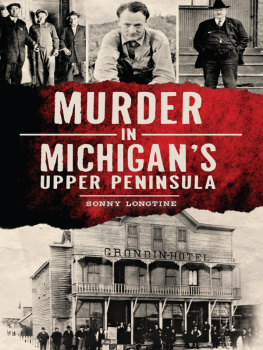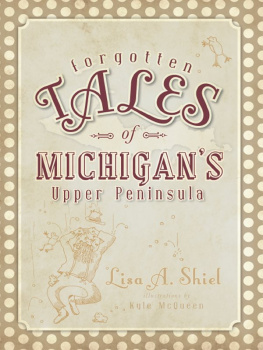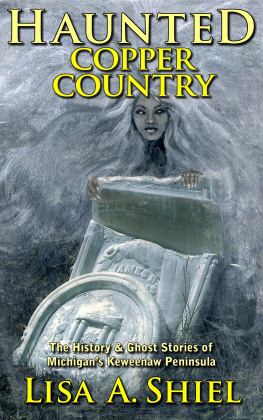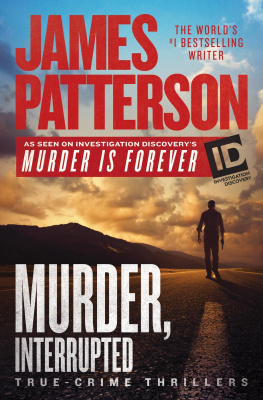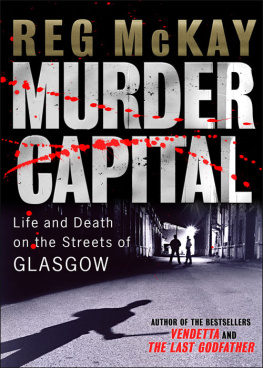

Published by The History Press
Charleston, SC 29403
www.historypress.net
Copyright 2014 by Sonny Longtine
All rights reserved
First published 2014
e-book edition 2014
ISBN 978.1.62584.847.5
Library of Congress Cataloging-in-Publication Data
Longtine, Sonny.
Murder in Michigans Upper Peninsula / Sonny Longtine.
pages cm
Includes bibliographical references.
print edition ISBN 978-1-62619-355-0 (paperback)
1. Murder--Michigan--Upper Peninsula--History. 2. Upper Peninsula (Mich.)--Social conditions. 3. Upper Peninsula (Mich.)--History, Local. 4. Upper Peninsula (Mich.)--Biography. I. Title.
HV6533.M5L66 2014
364.1523097749--dc23
2013050155
Notice: The information in this book is true and complete to the best of our knowledge. It is offered without guarantee on the part of the author or The History Press. The author and The History Press disclaim all liability in connection with the use of this book.
All rights reserved. No part of this book may be reproduced or transmitted in any form whatsoever without prior written permission from the publisher except in the case of brief quotations embodied in critical articles and reviews.
CONTENTS
ACKNOWLEDGEMENTS
Writing a book is a formidable task as well as solitary one, but without utilizing the specialized skills of others, this book would have never become a reality.
Victoria Tourtillott did the organization and image editing. Her unequaled attention to detail, particularly with the photographs, enriched the books presentation. She spent hours bringing old and seemingly unredeemable photographs to life. My never-ending requests for changes she completed with skill and patience. This was always appreciated.
Becky Tavernini skillfully edited the manuscript, ferreting out superfluous language and my never-ending need to editorialize. At times I wrote flourishing whimsical narrations that were excessive and distracted from the story. Beckys editing was clear: less is more. The result is a more tightly written text that quickly flows from page to page.
Judith Greene, an Arizonian, provided the artful sketches. At times she had poor-quality images to work with, but masterfully, she elevated them to print quality.
As always, Jack Deo and Superior View Studio provided me with photographs that I could not have obtained elsewhere.
John Pepin, a Mining Journal reporter, who expertly covered the Richardson murder trial, was a tremendous help in providing me with pointers on navigating a courtroom during a trial.
My friend Larry Flanders, a skilled teacher, writer and poet, superbly proofread the manuscript. He and his wife, Astrid, graciously provided shelter and sustenance on several of my research jaunts across the Upper Peninsula.
The following institutions and people contributed to make this book a reality.
INSTITUTIONS
Bayless Public Library
Beaver Island Historical Society
Houghton Mining Gazette
John Longyear Research Center
Leelanau Historical Society
Marquette Mining Journal
Michigan Technological University Archives/Van Pelt Library
Midland County Historical Society
Ontonagon Historical Society
Peter White Public Library
State of Michigan: Archives of Michigan Photo Collection
Wayne State University: Walter P. Reuther Library
PEOPLE
Mike Angeli
Karen Bahrman
Kathryn Carlson
William Cashman
Molly Crimmins
Don and Jeanie Culver
Jenette Ellens
Sue Girard/Jackson
Joe and Judy Gregorich
Christine Holland
Jim Humphrey
George Johnson
Bill Jorns
Dave Klimmek
Ellen Kroken
Sister Mary Ann Lauren
Patricia Lundberg
Laverne McDonald
Ann Miller
Karl Numinen
Shirlee Schwemin
John Stevens
Mary Stiles
Heather Sutton
INTRODUCTION
Murderers are supposed to look like murderers.
Surely they must have malicious grimaces; black, smoldering eyes; and menacing expressions that harbor hearts of darkness. Charlie Manson and Attila the Hun look like murderers. We like murderers to be easily identified. But most murderers are not evil appearing; they look no different from you and me.
Early research supported this notion that murderers or criminals could easily be identified by their appearance. At the turn of the century, famed Italian criminologist Cesare Lombroso carefully described the physiology of a criminal: hard, shifty eyes; a large, projecting jaw; a flattened nose; and fleshy lips were physical attributes that Lombroso said were common to criminals. His stereotypical criminal had more of a Neanderthal resemblance than that of modern man. Although his theory of criminal physiognomy has been largely discredited, it nonetheless has a popular following.
What one looks like, however, has little to do with whats in ones heart.
Ted Bundy, John Wilkes Booth and Lawrencia Bambi Bembenek hardly looked like murderers, yet juries found them guilty. Ted Bundy was dashing and articulate, yet he murdered thirty-one women. Handsome and charismatic Booth assassinated Abraham Lincoln, and Bambi Bembenek, vivacious and hauntingly beautiful, gunned down her lovers ex-wife.
Murder has many motivations. Greed, jealously, anger, power, insanity, retribution, survival and thrill all provide a basis for murder. Survival murders (spousal abuse) are easier to understand and forgive than those committed by a more sinister motivation. All murders are not equal.
Contrary to public opinion and television, not all murderers are caught. In 2012, Michigan had 689 murders, and many of the perpetrators are still free.
Solving murders is often related to demographics. Of the Michigan murders, 70 percent statewide were solved while only 45 percent were solved in Detroit. Literally getting away with murder is more than a trite expressionit happens, in some places more than others. The media reflects the publics interest in murder. Court TV, Law & Order and the CSI dramas on television inundate viewers with tales of ghastly murders. Bloody cadavers dissected by pathologists on television are now a common sight.
Michigans Upper Peninsula is a relatively remote and sparsely populated area, yet its relative remoteness has not prevented murders from occurring. While the per capita rate (five per year) is lower than in many other areas of the state, it nonetheless happens. And the Upper Peninsula fares no better in solving murders than other regions of the state, with 50 percent successfully prosecuted. Isolation does not ensure safety.
The 1967 movie Bonnie and Clyde, with Faye Dunaway and Warren Beatty, depicts glamorous, blood-soaked bank bandits as chic and popularized murder as a last resort for the oppressed. Bonnie and Clyde were seen as bank robbing Robin Hoods who took from the rich bankers who were the real enemies of the people. Spellbound audiences watched the movies end, where the protagonists were slaughtered in an orgy of blood and bullets, with sympathy. We abhor murder, but we watch it and read about it with mesmerized detachment.
We are mystified, scared, compelled and absorbed by murder; it is both repelling and alluring. Some murderers are intriguing or mysterious and titillate human curiosity, while others are eccentric, flamboyant egotists or neurotic compulsives.
Public interest in murder is not just a contemporary phenomenon; history is replete with a fascination for murder. The Elizabethans in the 1500s had a curious interest in pamphlets that described the crimes and trials of notorious characters, and executions were an enormous and delightful spectacle.
Next page
